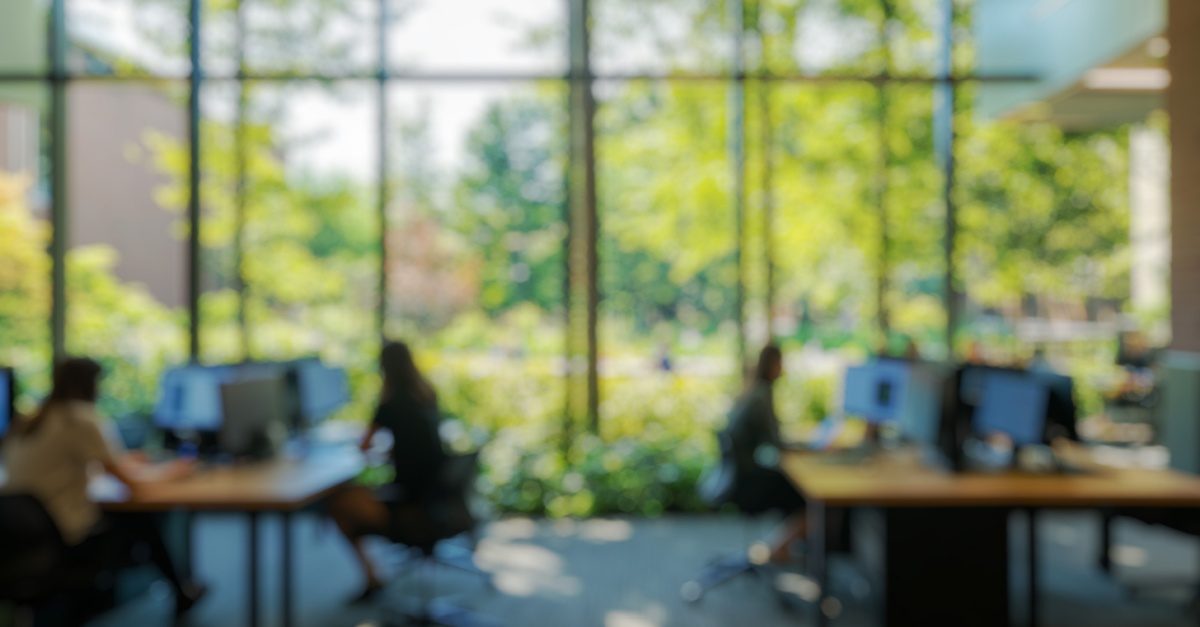
Creating green spaces: five top tips for businesses looking to renovate
When you’re renovating your business space, the first thing you consider will likely be the needs of your employees. Desk layout, technology choices, meeting spaces and the kitchen will all be top of the list to sort, so that everyone is comfortable and can work to their full potential. But have you thought about the carbon footprint of your new setup? Creating green space will differ for every business.
The ability you have to make eco-friendly choices will of course depend on whether you’re renting or own the building, as well as anyone else who shares the space with you. However, even small changes make a big difference, so make sure you think about this carefully at the planning stage. Here are some ideas to get you started.
Think about the future
A big part of being sustainable is simply choosing things that will last a long time – quality over quantity. While the initial outlay will likely be more expensive, you won’t have to keep replacing things, which can quickly add up in an office that is heavily used. Instead, when you’re researching your furnishings, look for materials that can easily be cleaned and are durable.
Additionally, try to avoid creating space or layouts that are only useful for one specific purpose. In the future, your team may change, so opt for furniture and spaces that can be adapted if needed, to avoid renovating again in the near future.
Heating and cooling
Heating and cooling is essential to making an office space comfortable. If you have the freedom to choose, then installing a heat pump or solar panels can provide you with green energy to keep your office at the right temperature. Again, while these are expensive to install, you’ll earn the money back thanks to the savings in your energy bills – so as long as the office is a long-term investment, this could be a good choice.
If these major changes are too much, then make sure your building is sufficiently insulated. This ensures that heat doesn’t escape unintentionally from your windows, doors and walls, as well as stopping hot air entering in the summer. The type of insulation you choose matters: sheep’s wool is one of the most eco-friendly choices, as it’s renewable – the sheep literally grow the wool back. It’s also known for being naturally fire resistant, and good at managing humidity levels.
Finally, consider your material choices. Big expanses of glass are also common in modern office buildings, but you’ll need to consider how this could impact the temperature when the sun is shining. Keeping the air conditioning constantly running won’t be good for your wallet or for the planet – so take time to consider the basics and get them right.
Lighting
Good lighting is key in any office – your team needs to be able to clearly see their screens, as working in poor lighting can lead to headaches and strained eyes. From a sustainability perspective, lack of natural light also means that artificial lighting will need to be on the majority of the day, using more energy than necessary.
So, when you’re renovating your space, think about what natural light you can bring in – or if you have no control over this, how you can position the desks to make the most of the light you do have. However, do remember to add blinds, so that your employees can adjust the light to avoid direct glare at peak sunny times.
Energy-efficient break spaces
Most offices have some kind of kitchen and break space, so you’ll need to consider the sustainability of this area as well as your main office space. Ensure that you’ve chosen energy-efficient appliances, such as a fridge and microwave, to avoid wasting electricity.
You could also install a boiling water tap instead of a kettle, as the majority of people will only be making one or two drinks at a time. Most people overfill their kettle, according to the Energy Saving Trust, so having water on demand can reduce waste and use less energy, as only the water needed is heated.
By having a proper kitchen, you’ll also encourage people to bring their own lunch, rather than having to go out to get food. Not only will this allow them to use the ingredients in their fridge at home, and therefore reduce food waste, but it also avoids using the disposable cutlery and cups that come with takeaway convenience meals.
Don’t forget to include recycling and food waste bins in your kitchen space, along with clear labels so that staff know how to use them.
Bring nature in
Plants are a great way to brighten up a neutral office environment, but they also have hidden benefits. According to Ciphr, plants can reduce stress and increase productivity, as well as clean the air and reduce noise levels. Green is often seen as a calming colour. Of course, you’ll need to choose varieties that are suited to the space, as well as ensuring they’re low maintenance so that they don’t just droop if someone misses the watering schedule. Succulents, rubber plants and peace lilies can be a good choice, or you could encourage staff to choose their own for their desks.
If you have any outdoor space, a renovation is also a chance to upgrade this too. Creating a green place where staff can take a break or even have a change of scenery for a meeting is a lovely way to create a welcoming workspace as well as providing a home for nature.
Author bio: James Jenkins
James works as a sustainability consultant, advising businesses on the changes they can make to be more eco-friendly. As a result, he’s seen plenty of office spaces – he hopes this post can inspire companies to bring sustainability into the heart of their renovations.
Time is running out to submit your nomination for this year’s Sustain Chain Awards! Take a look at the categories, which range from awards for green initiatives to individual contributions and submit your FREE nomination HERE.

